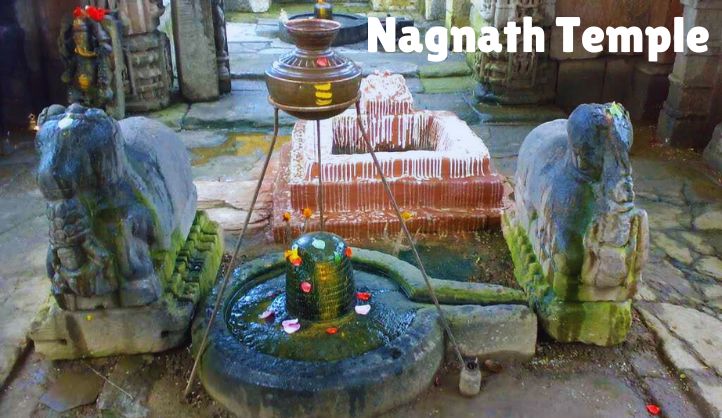Tucked away in the serene hills of Champawat, Uttarakhand, lies the ancient Nagnath Temple, a spiritual sanctuary dedicated to Lord Shiva. This sacred site, revered for its historical significance and architectural beauty, attracts pilgrims, history enthusiasts, and travelers seeking a glimpse into the rich cultural heritage of the Kumaon region.
Historical Significance
The Nagnath Temple is believed to have been constructed during the Chand dynasty‘s reign, which flourished from the 10th to the 18th century. This dynasty was instrumental in promoting art, culture, and architecture in the Kumaon region. The temple, dedicated to Lord Shiva, stands as a testament to their devotion and the architectural prowess of the era.
Architectural Marvel
The Nagnath Temple showcases the exquisite Nagara style of architecture, typical of northern India. This style is characterized by its curvilinear towers (shikhara), intricate stone carvings, and beautifully sculpted idols. The temple’s sanctum sanctorum houses a Shiva Linga, symbolizing the presence of Lord Shiva, and is a focal point of devotion for visitors.
The temple’s exterior is adorned with detailed carvings depicting scenes from Hindu mythology, intricate floral designs, and divine figures. These artistic elements not only enhance the temple’s aesthetic appeal but also offer a glimpse into the skilled craftsmanship of the period.
How to Reach
By Air
The closest airport is Pantnagar Airport, located approximately 180 kilometers from Champawat. You can hire a taxi from the airport or take a bus to Champawat.
By Train
The nearest railway station is Kathgodam, about 75 kilometers away. From Kathgodam, you can hire a taxi or take a bus to Champawat.
By Road
Champawat is well-connected by road to major cities such as Delhi (approximately 450 kilometers) and Dehradun (around 370 kilometers). Buses and taxis are readily available to reach Champawat from these cities.
Spiritual Significance
As a revered site dedicated to Lord Shiva, the Nagnath Temple holds profound spiritual significance. Devotees visit the temple to seek blessings, offer prayers, and perform rituals. The tranquil ambiance of the temple, coupled with the surrounding natural beauty, provides a serene environment for meditation and reflection.
Cultural Heritage
The Nagnath Temple is a repository of cultural heritage, reflecting the religious and artistic traditions of the Kumaon region. The temple’s annual festivals, particularly Mahashivaratri, draw large crowds of devotees who come to participate in the celebrations and rituals. These festivals display local culture and religious fervor, adding to the temple’s charm.
Visitor Experience
Visiting the Nagnath Temple offers a unique blend of spiritual enrichment, historical exploration, and natural beauty. The temple’s serene location in Champawat, surrounded by lush greenery and picturesque landscapes, makes it an ideal destination for those seeking solace and a deeper connection with nature and spirituality.
Things to do in temple
Offer Prayers and Seek Blessings
Nagnath Temple is dedicated to Lord Shiva, making it a significant place for offering prayers and seeking blessings. Participate in the rituals and prayers conducted at the temple to experience the spiritual ambiance.
Explore the Architecture
Admire the intricate Nagara-style architecture of the temple. The temple’s exterior and interior are adorned with beautifully carved sculptures depicting mythological themes and divine figures. Take time to appreciate the craftsmanship of ancient artisans.
Attend Festivals
If your visit coincides with festivals like Mahashivaratri, immerse yourself in the festive spirit. Witness special rituals, devotional songs, and cultural performances that celebrate the glory of Lord Shiva.
Photography and Sightseeing
Capture the beauty of Nagnath Temple and its surroundings through photography. The serene hills and lush greenery provide a picturesque backdrop for memorable snapshots.
Learn about History and Legends
Engage with local guides or priests to learn about the temple’s history, legends, and significance in Hindu mythology. Gain insights into the cultural heritage of Champawat and its connection to the Chand dynasty.
Enjoy Spiritual Reflection
Take moments of quiet contemplation and spiritual reflection within the temple premises. The peaceful environment is conducive to meditation and introspection.
Some places you can explore
Baleshwar Temple
Located in Champawat itself, Baleshwar Temple is another ancient Hindu temple dedicated to Lord Shiva. It dates back to the 10th century and is renowned for its intricate architecture and spiritual significance. The temple’s serene ambiance amidst the hills makes it a peaceful retreat for visitors.
Lohaghat
Approximately 14 kilometers from Champawat, Lohaghat is a quaint town known for its natural beauty and historical importance. It offers panoramic views of the Himalayas and is a great spot for nature walks and photography. The town also has temples and historical sites worth exploring.
Purnagiri Temple
About 40 kilometers from Champawat, Purnagiri Temple is situated atop a hill and is dedicated to Goddess Purnagiri. It is one of the 108 Shakti Peethas and is revered by devotees who undertake the pilgrimage to seek blessings. The temple offers stunning views of the surrounding mountains and valleys.
Abbott Mount
Located around 20 kilometers from Champawat, Abbott Mount is a charming hill station known for its old colonial-era cottages and panoramic views of the Himalayas. It is an ideal destination for nature lovers, bird watchers, and those seeking tranquility amidst pine and oak forests.
Mayawati Ashram
Mayawati Ashram, situated near Lohaghat, is a spiritual retreat founded by Swami Vivekananda. It offers a serene environment for meditation and introspection amidst lush green surroundings. The ashram also houses a library and a museum dedicated to the life and teachings of Swami Vivekananda.
Champawat Fort
Champawat Fort, located in the town itself, is a historical site that dates back to the Chand dynasty. It offers insights into the region’s rich history and architecture, with remnants of old fortifications and a commanding view of the surrounding area.
Patal Bhubaneswar Cave Temple
Although a bit farther (around 100 kilometers), Patal Bhuvaneshwar Cave Temple is a fascinating underground cave temple dedicated to Lord Shiva. It is renowned for its intricate stalactite and stalagmite formations that resemble various deities and mythological figures.
Devidhura
Devidhura, around 50 kilometers from Champawat, is known for its unique Bagwal festival where stones are thrown in a symbolic battle among villagers. Apart from its cultural significance, Devidhura offers beautiful landscapes and a serene environment for travelers.
Conclusion
The Nagnath Temple in Champawat, Uttarakhand, is a hidden gem that offers a harmonious blend of spirituality, history, and natural beauty. Its ancient architecture, coupled with its serene surroundings, makes it a must-visit destination for anyone exploring the cultural and spiritual heritage of the Kumaon region.
Whether you are a history buff, a spiritual seeker, or a nature lover, a visit to Nagnath Temple promises to be a rewarding experience, leaving you with lasting memories of this sacred and historical site. Plan your journey to Champawat and immerse yourself in the divine and historical ambiance of Nagnath Temple, where every corner tells a story of devotion and architectural brilliance.
FAQs About Nagnath Temple
1. What is the historical significance of Nagnath Temple?
Nagnath Temple is believed to have been built during the reign of the Chand dynasty, which ruled the Kumaon region from the 10th to the 18th century. It reflects the architectural and cultural heritage of that period and is dedicated to Lord Shiva.
2. Where is Nagnath Temple located?
Nagnath Temple is located in Champawat, a town in the Champawat district of Uttarakhand, India. It is nestled amidst the scenic hills of the Kumaon region.
3. What is the architecture of Nagnath Temple like?
The temple showcases the Nagara style of architecture typical of northern India. It features intricately carved stone structures, including the main sanctum housing a Shiva Linga. The temple’s exterior is adorned with detailed sculptures depicting mythological themes and floral patterns.
4. What is the significance of visiting Nagnath Temple?
Nagnath Temple holds profound spiritual significance for devotees of Lord Shiva. Visitors come to seek blessings, perform rituals, and experience the peaceful ambiance conducive to meditation and reflection.
5. Are there any festivals celebrated at Nagnath Temple?
Yes, Nagnath Temple celebrates festivals such as Mahashivaratri with great enthusiasm. Devotees gather to participate in special prayers and rituals dedicated to Lord Shiva during these festivals.





